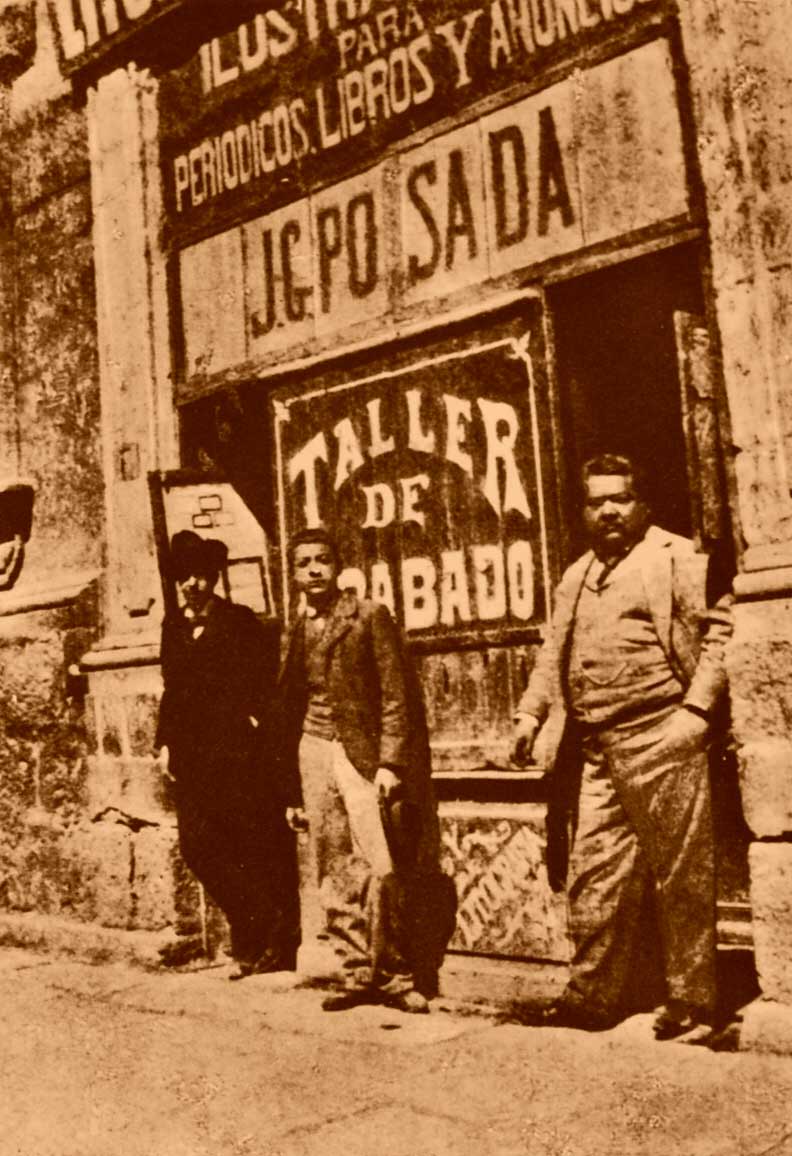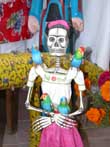ARTIST GALLERY
Jose Guadalupe Ruiz Aguilar Posada- (born, Aguascalientes, Mexico, February 2, 1852 – January 20, 1913)
Available artwork: Broadsides Halfsheets Chapbooks Restrikes
 <- Photo: JG Posada’s Mexico City print shop circa 1900 <- Photo: JG Posada’s Mexico City print shop circa 1900
There are numerous scholarly works chronicling what is known about José Guadalupe Ruiz Aguilar Posada. For more detailed information about Posada please refer to the references listed on this website. The synopsis below is derived mainly from three excellent sources: Mock, Melodie, HOJAS VOLANTES: José Guadalupe Posada, the Corrido, and the Mexican Revolution, University of North Texas Master of Arts Thesis; Tyler, Ron (editor), 1979, Posada's Mexico. Washington: Library of Congress and Amon Carter Museum and the Jean Charlot Posada Collection website of the University of Hawaii http://www.hawaii.edu/artgallery/posada.html.
In brief summary, Posada received his early childhood schooling at an Aguascalientes elementary school run by his older brother José Cirilo (1839-1894). At an uncle's pottery workshop Posada acquired rudimentary experience in design. He later received formal instruction in drawing at the Municipal Academy of Drawing. Aguascalientes records show that by the age of fifteen, Posada was registered as a painter. In 1868, he learned lithography while working as an illustrator in the workshop of José Trinidad Pedroza.
In 1872, Pedroza moved to León, Guanajuato and within a year or so he was joined by Posada where they ran a printing and lithography workshop. In 1873, Pedroza returned to Aguascalientes leaving Posada in charge of the workshop. He remained in Leon for the next sixteen years working in a variety of mediums from lithography to engravings. His subject matter varied including: political caricatures, advertising art, religious images and news illustrations. He created images for local printing houses and numerous religious publications. Beginning in 1883, he taught lithography at the Leon secondary school for approximately one year.
In 1887, a flood in Leon destroyed Posada’s workshop and possibly caused the death of several members of his family. Prior to the flood Posada had developed relationships with several publishers in Mexico City. Together with these contacts and possibly with the desire to seek improved opportunity in a larger market, Posada moved his business to Mexico City and opened his first workshop at Calle Cerrada de Santa Teresa. Posada is known to have created images for over twenty-three Mexico City based periodicals, including: the dailies, Gil Blas, El Popular (1897-1907), El Amigo del Pueblo (1897), and El Argos (1903-04); the weeklies Gil Blas Cómico (1893-96), La Patria Ilustrada (1886-90), El Fandango (1890-92; 1895), La Risa del Popular (1897-98), Revista de México (1889-91), El Chisme (1899-1910), El Diablito Rojo (1900-1910), El Paladin (1901-10), La Guacamaya (1902-11), El Padre Padilla (1908), San Lunes (1909), and irregular issued publications such as La Gaceta Callejera (Street Gazette) (1892-94).
Beginning in 1888, Posada began working predominantly for the Mexico City based publishing house of Antonio Vanegas Arroyo. The publications produced by Vanegas Arroyo were circulated around much of Mexico and less frequently into Spanish speaking portions of North America. The adult level of literacy in Mexico in 1910 is reported to have been 32%. Vanegas Arroyos’ understanding of the market for his publications possibly aided him in hiring Posada as his chief illustrator. Vanegas Arroyo clearly needed someone who could craft an illustration in which the graphics communicated as much as possible regardless of the viewer’s degree of literacy. In Posada, Vanegas Arroyo found an illustrator whose images of folk heroes; sensational crimes and disasters supported the story lines and more often than not, stood on their own in such a way that they required no words at all.
Posada produced illustrations for a myriad of work including: children's stories, plays, instructional books, songbooks, histories, almanacs, card games, game boards, recipes, love letters, commercial advertisements, business letters and religious publications. The religious imagery most often depicted saints, perspectives of Jesus Christ crucified and various renderings of Our Lady of Guadalupe.

Image: Paper mache Frida Kahlo calavera, private collection Jennifer Haas ->
Small pamphlets containing popular tales, songs, and verses were called chapbooks. Images were printed on a variety of newsprint quality paper stock, sometimes the paper was colored, sometimes images were hand colored and many images were used over again for different stories. In the tradition of the European broadside, a variety of paper sizes were produced reporting and illustrating current events, verses, and songs called corridos. As with Manilla, the skeleton images called calaveras were produced for the Dia de los Muertos. The calaveras were issued along with corridos or verses usually satirizing some poignant issue of the day or showing living persons as though they were dead.
It is an interesting twist that in his lifetime Posada would popularize the calavera images only to die in obscurity at the age of 61 on January 20, 1913 at his home, to be buried in an unmarked grave, and then discovered years after his death. The French ex-patriot artist Jean Charlot, who described Posada as “printmaker to the Mexican people”, initiated this discovery in the 1920s. His art, Charlot thought, was connective to Mexico’s history and influential to the modern Mexican art movement. Chalot proved to be right and thanks to his insight and work, Posada’s contribution was given recognition. Mexican muralists Diego Rivera (1886-1957) and José Clemente Orozco (1883-1949) would later give credit to Posada for his inspiration and influence. Dozens of authoritative books, national and international exhibitions, inclusion into countless museum collections and auctions where his works command thousands of dollars are testimony to Posada’s continuing and growing legacy.
Available artwork: Broadsides Halfsheets Chapbooks Restrikes |

